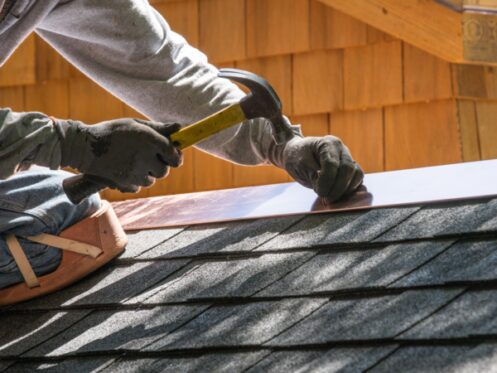Flashing is a special part of your Roseville roof that helps keep it safe. It is made of thin metal and is used to keep water out of places where it might leak into your house. The flashing helps the water go to the right place by leading it away from the risky parts of the roof and towards the gutter. There are different kinds of flashing, like ones that go around chimneys, skylights, and vents. Some kinds of flashing also protect the roof where it touches the walls of your house.
Continuous Flashing
Continuous flashing waterproofs the area where your roof comes in contact with vertical walls. You might hear this referred to as apron flashing. It is a long piece of flashing that, similar to an apron, directs water down the shingles.
Base Flashing
You will commonly find this flashing around a chimney or another part of the roof that needs multiple pieces of flashing to make it watertight. Your roofer will install base flashing at the joint where the roof has a vertical feature, like a chimney.
Step Flashing
Some roofers use a type of flashing called “step” or “two-part” flashing, which is different from continuous flashing. This type of flashing is commonly used to make sure that the place where a vertical wall meets the roof is waterproof. Two-part flashing gets its name because it wraps around itself, like steps. It is usually made of aluminum, but some people use copper, even though it costs more.
Counter Flashing
We typically use counter flashing with base flashing to enhance its waterproofing abilities. It covers the top part of the base flashing, which provides additional protection against water infiltration.
Vent Pipe Flashing
Vent pipe flashing is a type of material used to seal pipes that stick out of the roof for ventilation. Its purpose is to stop water from leaking through and also to keep drafts from entering the house.
Valley Flashing
A valley on a roof is where two sections of the roof with different slopes meet. In order to protect this area, we install valley flashing along the open valleys of the roof. The flashing serves two purposes. It guides water off the roof along a proper pathway and helps prevent debris from accumulating on the roof.
Clap Flashing
We use clap flashing to protect a roof in a similar manner as counter flashing by overlapping with another piece of flashing at a right angle. It is commonly used to safeguard the area surrounding chimneys on residential buildings.
What Materials Are Used for Making Flashing?
Manufacturers usually use thin metal to make roof flashing. The three metals that are commonly used for roof flashing include the following.
Aluminum is the most popular choice because it is lightweight and we can easily shape it. Copper lasts longer than aluminum and is also malleable, but it is often more expensive. We often use copper flashing around chimneys. Steel looks better than other metals and can withstand rust when coated with zinc.
Roofing companies may offer rubber flashing, but it is not durable and can fail. Plastic flashing is waterproof but can deteriorate when in contact with asphalt shingles. Felt is not a good flashing material on its own because it is not waterproof. It is only useful when used with other roofing materials.
When securing flashing, we usually use nails or roofing cement. However, nails are not flexible, which can cause damage to the flashing if the roof expands or shrinks due to changes in the weather. Roofing cement is a better option because it is flexible and can move with the roof.
Professional Roofing in Roseville
Clark's Gables Roofing has been offering roofing services for over 35 years. We take pride in focusing on one roof at a time and aim to finish each project within three days. We ensure all necessary licenses, permits, and insurance are in place to provide top-notch service. Our roofers follow California’s Title 24 energy-efficient standards. We are happy to blend traditional customer service with modern roofing techniques to create beautiful, durable, and high-quality roofs.
Our services include installing, maintaining, and repairing concrete tile roofs. We fix leaks around chimneys, damaged underlayment, flashing leaks, and dry rot that affects the barge and fascia. We replace and upgrade asphalt shingle roofs, standard-weight tile, lightweight tile, and stone-coated steel. Contact Clark's Gables Roofing today and see what it is like to work with a company that makes your roof the priority.




